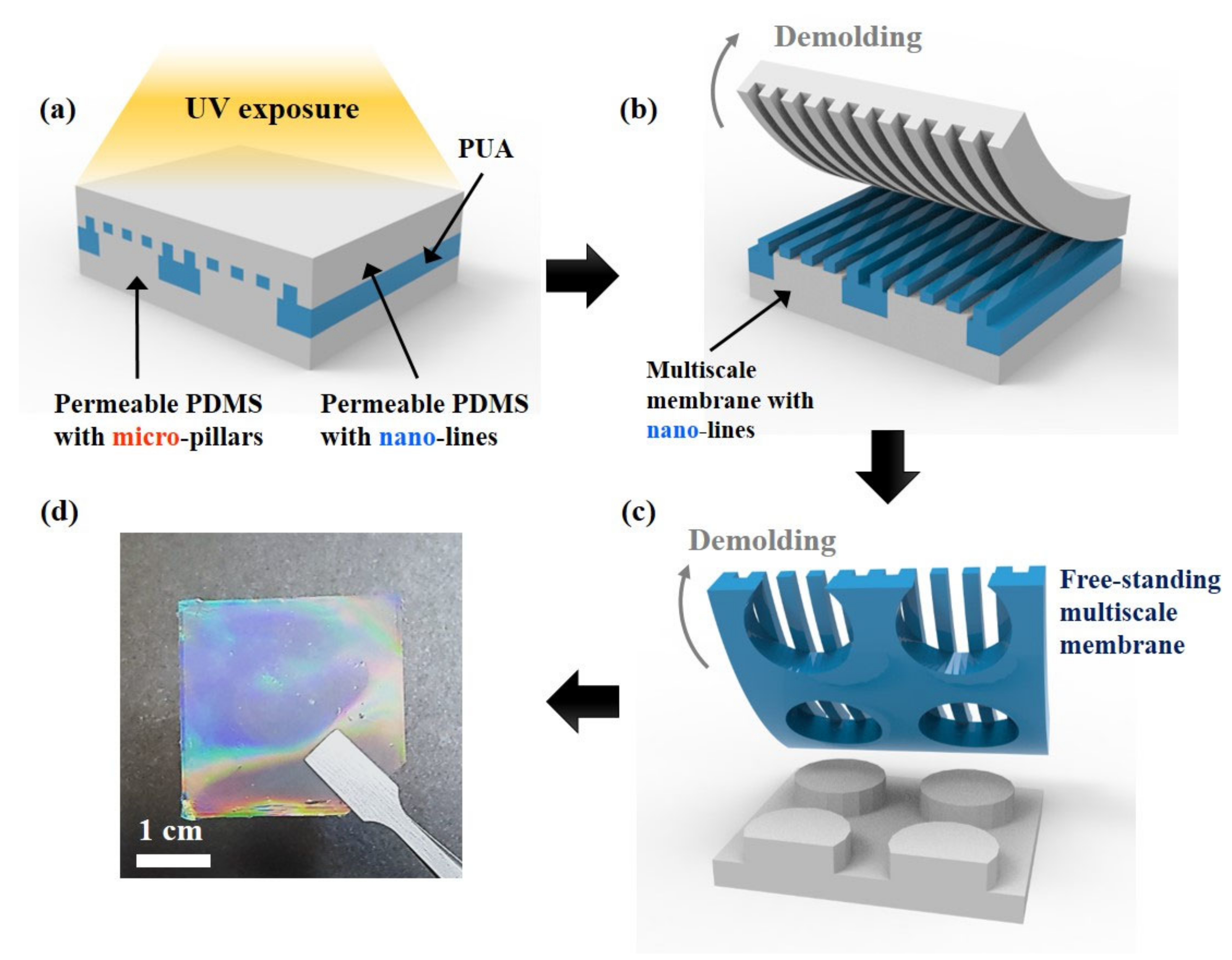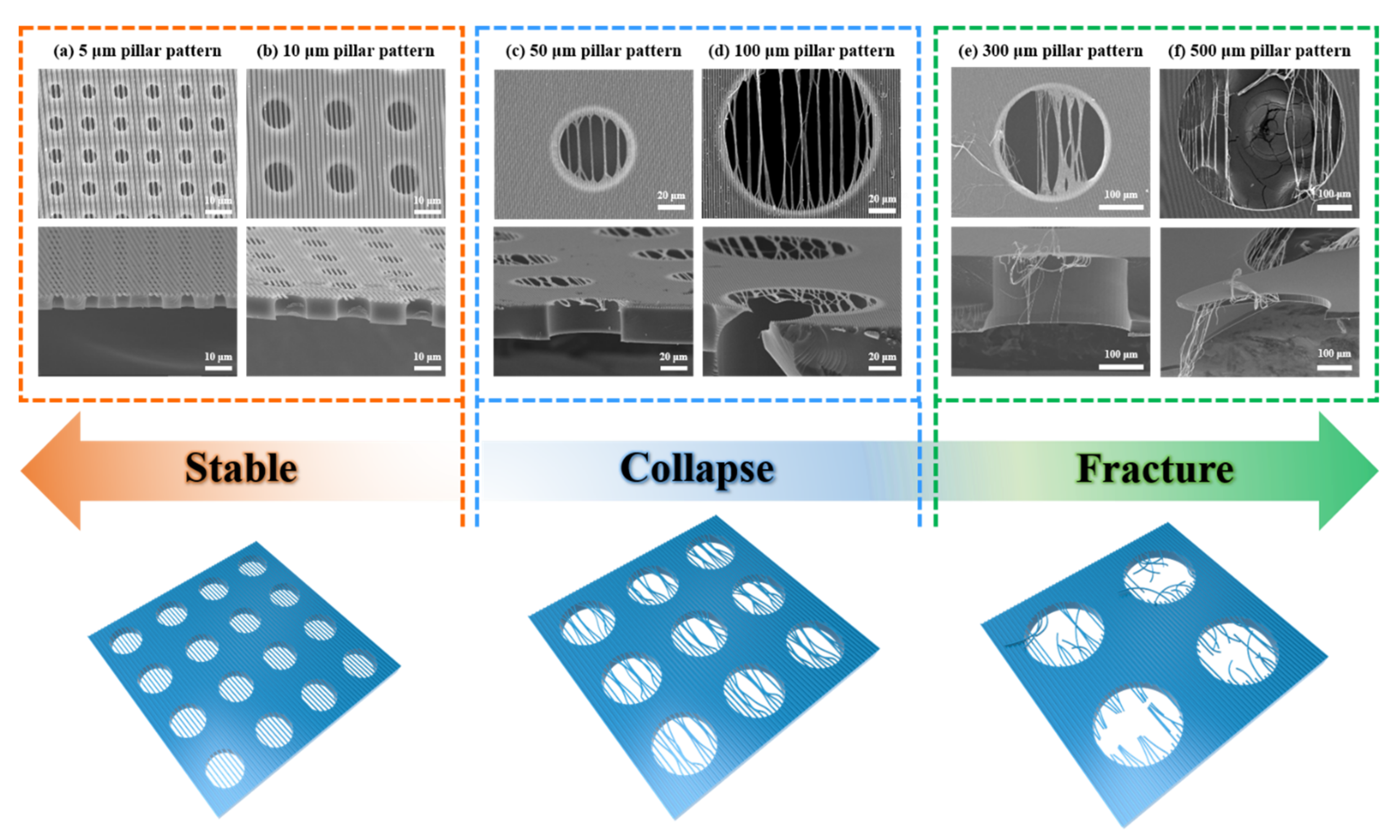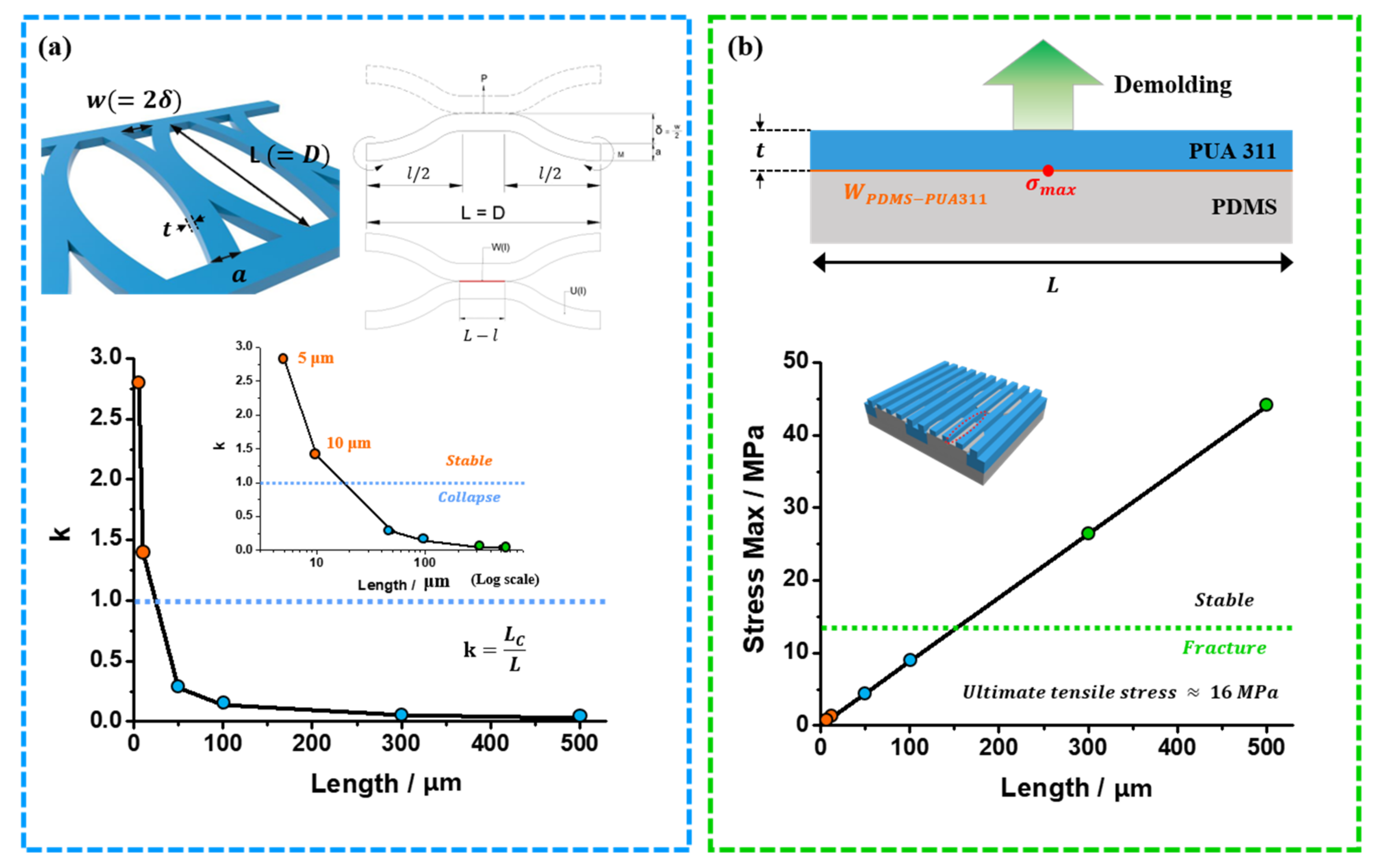1. Introduction
Thin membranes possessing micro-/nano-scaled apertures have been extensively developed for a wide range of applications, including deposition masks, lithography masks, etching masks, microfluidic devices and filters [
1,
2,
3,
4,
5,
6,
7]. A variety of techniques to improve the stability of the nanostructured membrane have been explored using diverse materials, factoring in corresponding surface energy, elasticity, transparency and surface hydrophilicity, depending on its purpose. When it comes to the thin membrane with a precisely controlled aperture size and arrangement, nanostructured silicon nitride (SiN
x) membranes supported on rigid Si membranes have been used due to its superiority in mechanical rigidity as well as structural controllability [
4]. Due to its rigidity, the ultra-thin layer of the SiN
x membrane is likely to suffer from mechanical damage (cracks, breakdown, fractures, etc.) during handling for fabrication processes. It also requires complicated processes with high fabrication costs. As one of the contenders, free-standing stencils with polydimethylsiloxane (PDMS) has been fabricated through a soft lithography process thanks to several advantages, such as a low cost, conformal contact, flexibility, ease of process, the low mechanical strength and low elastic modulus, which rules out possible physical damages [
8]. However, an implementation of polymeric flexible materials has its benefits, such as inducing folding/crumpling phenomena during the fabrication process, which leads to a limit in the aperture size and thickness [
9,
10]. To address these issues, a polymeric nano-aperture membrane monolithically constructed on a supporting layer with micro-apertures was reported previously [
11,
12]. The one-step process based on the scavenging effect of the infiltrated oxygen gas is highly advantageous in the facile fabrication of free-standing membranes with nano/micro two-level apertures. Furthermore, the stability of the periodically arranged nano-holes supported on microscale circular apertures, considering the adhesion forces in the demolding process, has been investigated to realize the stable fabrication of ultrathin membranes with nano-scale apertures [
13]. Unlike 2-dimensionally (2D) closed-hole patterns on the polymeric membrane, the construction of a 1D line-patterned membrane causes directionally sensitive structural instability during the demolding or handling process in two aspects: The one is the lateral-direction collapse of the neighboring nano bridges, and the other is the vertical-direction fracture of the nano bridges. To overcome these issues in reliable reproduction, a 3D approach should be considered for improved mechanical stability.
Herein, we report the design rule in the formation of the 1D nano-line membrane over the micro-hole supports, which provides the geometrical restriction for the design of polymeric membranes with two-level apertures. To investigate the overall 3D mechanical stability, we conducted six sets of 1D line-shaped polymeric membranes with varying micro-pillar diameters (5 μm, 10 μm, 50 μm, 100 μm, 300 μm and 500 μm) in fixed conditions with a nano-line width (w) of 800 nm. From the results, we categorized the structures in three cases: (1) stable, (2) collapse and (3) fracture, and suggest a model that explains the physical mechanism of the lateral collapse with the vertical fracture during the demolding process when peeled-off from the micro molds.
3. Results and Discussion
In order to handle and use the nano bridges as a mask or filters, supporting layers with micro-sized apertures for free-standing nano bridges are required. It is generally known that as the size of the apertures of the supporting layer gets wider or bigger, the extremely thin bridges get unstable, inducing collapse or fracturing of the bridges. Hence, a proper geometrical design for the fabrication of two-level multiscale polymeric membranes is needed. To investigate the mechanical stability of the monolithic nano bridges on the micro apertures, the diameter of the micro-pillars PDMS molds were varied, while the geometry of the nano-line was fixed. In this study, the micro-pillar PDMS molds with a diameter of 5 μm, 10 μm, 50 μm, 100 μm, 300 μm and 500 μm, and the nano-lines mold with a line width of 800 nm, were used to construct the two-level multiscale polymeric membrane. The spacing ratio (SR: spacing between pillars (or lines) divided by diameter (or line width)) of all the PDMS molds was the same. The scanning electron microscopy (SEM) images of six types of micro-pillars and one type of nano-lines PDMS mold are shown in
Figure 1; the detailed information about the fabrication process of the patterned silicon master and PDMS molds is provided in the Materials and Methods section.
The fabrication process of the two-level multiscale polymeric membrane is illustrated in
Figure 2. The multiscale polymeric membranes were fabricated by using the UV-curable polyurethane acrylate (PUA) resin, micro-pillars PDMS mold and nano-lines PDMS mold. First, the PDMS resin was poured onto the Si master molds of the nano-lines and micro-pillars and cured at 70 ℃ for 2 h to obtain the PDMS patterned molds [
13]. Then, PUA pre-polymer was dispensed onto the micro-pillar PDMS mold and the nano-line PDMS mold was placed on it. The contact surface area between the nano-lines and micro-pillars formed overlapped oxygen-infiltrated layers (OILs) due to the gas permeable property of the PDMS, which resulted in delayed UV curing under the ultraviolet irradiation at the contact area [
7,
14,
15,
16]. The sandwiched layers (nano-lines PDMS mold–PUA resin–micro-pillars PDMS mold) were properly irradiated with UV light with an intensity of 20 W cm
−2 for 2 min. After the cured PUA membrane was detached from the PDMS mold, the membrane was treated with UV curing for 4 h to fully treat the partially cured resin on the surface. After the fabrication process, the free-standing two-level multiscale polymeric membrane, which includes the monolithic nano bridges over the micro apertures, was obtained, as shown in
Figure 1d. The uniform iridescent color of the membrane indicates that the nano-lines were successfully constructed over the large area (~3 cm × 3 cm).
With the prepared PDMS molds and PUA pre-polymer resin, the two-level multiscale polymeric membranes have been successfully constructed through the fabrication process, and the six types of nano bridges monolithically constructed on the micro-aperture membrane were observed through SEM, as shown in
Figure 3. The results show that the nano bridges are stably sustained on the supporting layer of the micro-aperture structures with a diameter of 5 μm and 10 μm. In other cases, structural failures of nano bridges occurred, meaning that the nano bridges were deformed, fractured or unsupported by the layer. The failures are classified by two cases, which are the collapse of thin nano bridges in the lateral direction and fracture of the bridges in the direction perpendicular to the line direction. In the cases of the 50 μm and 100 μm sizes of the supporting layer, which are relatively smaller than that of the 300 μm and 500 μm sizes, the centers of the nano bridges were collapsed or clustered together. In turn, in the case of the 300 μm and 500 μm micro aperture sizes of the supporting layer, fracture and collapse of the nano bridges occurred simultaneously during the detaching process. As the micro aperture size of the supporting layers increases, the thin nano bridge structures get unstable, as expected. From the observation, the finally constructed two-level multiscale polymeric membrane can be categorized in mainly three cases: (1) stable, (2) collapse and (3) fracture and collapse. To analyze these phenomena and set the criteria for each stability, it is necessary to separate the observational view of the structures. Since the collapse, which is determined by the geometrical features of line width, the gap width of the lines and the micro aperture size should be considered in the top view of the structure. In turn, the fracture, which is determined by the geometrical features of line thickness, and the micro aperture size should be considered in the side view of the structures.
In order to propose simple theoretical models to set the stability criteria for the collapse phenomenon in the lateral direction and fracture phenomenon in the vertical direction, a model where the beam structure and nano bridge are fixed at both ends is assumed. First, to establish a criterion for lateral stability of the nano bridges, we model the collapsing of the bridges as depicted in the inset of
Figure 4a, in which two neighboring line bridges adhere to each other. The adhesion between the bridges induces a distributed bending moment
M(
x) with an adhesion force,
P.
where L is length of the bridge, which is same with the diameter of the micro aperture.
Then, the strain energy (U) of the deformed structure can be given as follows:
The contact region is set to be located at the center of the bridge because it gives the minimum strain energy at a given geometry. Let
be the length of the non-contact region where the elastic strain energy is stored. The bridges will not collapse when
L− l < 0. Thus,
l is the minimum length of the bridge to be stable. We denote
Lc as a critical length of
l. The strain energy of the non-contact area of the bridges, where bending deformation is dominant, is stored, while that of the contact area is not stored [
17,
18]. Based on the assumption, the total strain energy of the system is expressed as follows:
where
E is elastic modulus, δ is deflection length of the bridge and
I is second moment of inertia of the deflected bridge,
I =
ta3/12 (a: width of bridge; t: thickness of bridge). From the relation,
U is defined as a function of the geometrical features.
Regarding energy conservation, the energy balance between the adhesion energy and strain energy is expressed as follows:
where
(
) is the surface energy of the bridges, which is calculated based on the geometric mean method.
where
is the surface tension of liquid,
is the contact angle of the liquid on the solid surface, superscript d refers to disperse and superscript p refers to polar. By measuring the contact angle of two liquid materials, which are DI water and ethylene glycol on the surface, the surface energies in the polar term and in the disperse term are calculated, respectively (
Figure 5). The total surface energy (γ) of solid material is obtained by adding up the two terms of surface energy (
Table 1).
Then, the critical length is determined as follows:
If we denote k as a stability indicator, then
Then, the condition for lateral stability is
. In this case, the structure would be stable. If k ≤ 1, the structures would be laterally collapsed. As shown in graph in
Figure 4a, in our experimental set, the lateral collapse would occur except for the case of 5 μm and 10 μm, in which the k value is over 1. The anticipated results based on the criteria are in good agreement with the experimental results. It can be used toward the design rule for the lateral collapse of nano-layers constructed on the micro-aperture structures.
When the nano-line length was 300 and 500 μm, not only the collapse phenomenon of the nano bridges but also the fracture phenomenon at the center of the nano bridges was observed. To elucidate this phenomenon, we proposed a model of mechanical stability of the beams fixed at both ends under constant distributed loads [
13]. When the beam fixed at both ends was under the uniformly distributed load, the maximum allowable stress can be derived as follows [
19]:
where
Mcenter is the moment at the center of the beam,
ymax is the maximum distance across the beam from the center of the beam,
I is the area moment of inertia of the beam,
q is the stress applied to the beam and
h is the length of the beam. The allowable beam deflection at the center of the beam is assumed to not exceed the thickness of the nano bridge (~ 400 nm), and the applied stress
q is the work of adhesion required to detach the PUA 311 membrane from the PDMS mold. At the center of the nano-bridges is applied the maximum stress. It is generally known that the fracture of the structure occurs when the applied stress exceeds the ultimate tensile stress (~16 MPa) [
20,
21]. To calculate the work of adhesion, we used following harmonic mean method equations:
where the superscripts
p and
d are for the polar and dispersed components of the surface tension γ, respectively; these values are summarized in
Table 1. The calculated work of adhesion is about 28.14 mJ/m
2, which is a uniformly distributed load on the nano bridges when the PUA membrane was detached from the PDMS mold. Therefore, Equation (10) can be substituted with the following equation:
From Equation (12), we can calculate the maximum applied stress depending on the length of nano bridge structures.
Figure 4b shows the illustration of the work of adhesion at the interface between the PDMS mold and PUA 311 nano-layers, as well as the plotted maximum tensile stress for the cases 5 μm, 10 μm, 50 μm, 100 μm, 300 μm and 500 μm. As shown in the graph, the maximum applied stress of the 100 μm and lower pore diameter is lower than ultimate tensile stress of PUA 311. As a result, the fracture phenomenon is not observed for nano bridges supported on micro-aperture diameters of 5 μm, 10 μm, 50 μm and 100 μm. Contrariwise, the maximum applied stress of the 300 μm and 500 μm pore diameters is higher than the ultimate tensile stress of PUA 311, and some fractures are observed as unstably supported on the micro-aperture. These design rules can be used as a guideline for the fabrication of flexible and free-standing membranes with nano-line structures monolithically constructed on the micro-aperture membrane.










